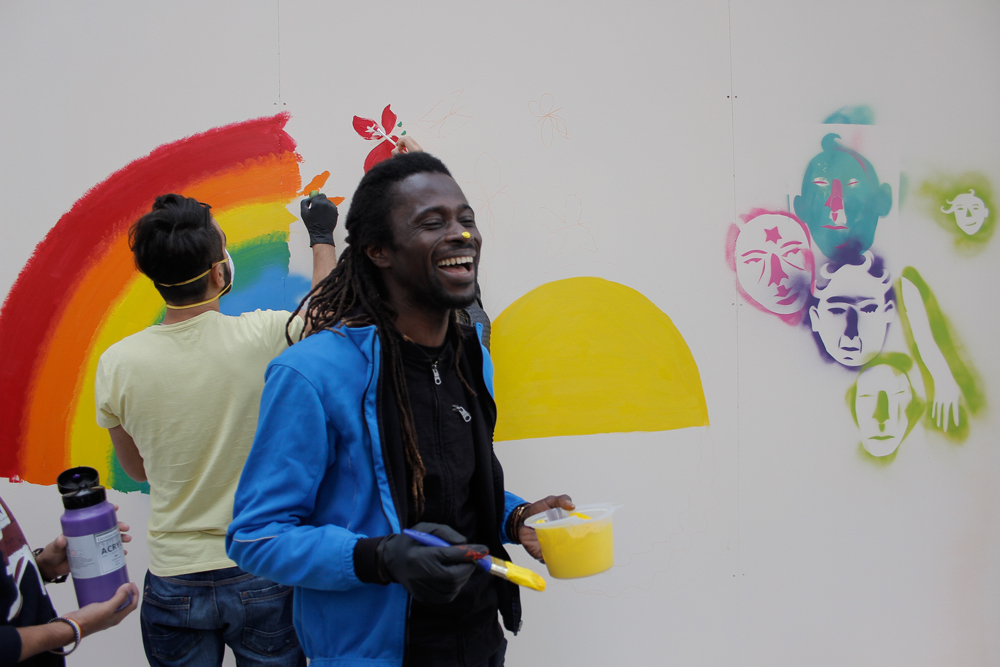
The creative fillip
– Creative workshops for
socially disadvantaged people
In her creative workshops, “the creative fillip”, graphic designer Elisabeth Marek offers people in difficult life situations a safe space for artistic development. By experimenting with different materials and techniques, they can discover their artistic potential here and take a “mental break” from their everyday worries.
There are many barriers that disadvantage people socially, economically or culturally. Perhaps they can’t cope with the institutional education system, or can hardly afford their lives, are unemployed or have had to flee from terror, violence and war. Unemployment, poverty and flight have become global problems on an unprecedented scale.
Often, people in such difficult situations have no “time out”. They have almost no opportunity to break out of their everyday lives, which are often dominated by problems. The social project “the creative fillip” set up by Elisabeth Marek has developed a very special
solution approach to this problem: it is based entirely on the power of creativity, and provides an artistic
“time out”. In this way, people in problematic life situations are given the chance to leave their troubles behind, at least for a short while. At the same time, they can find out about and use their creative potential in a safe environment.
A creative break to foster
courage and self-belief”
“The creative fillip” was founded in 2013 by the graphic
designer Elisabeth Marek. Since she didn’t enjoy working alone at the computer, she decided to set up a project that challenged her. Her aim was to enable other people to develop their creative manual skills. People in difficult situations in particular need such spaces to be able to develop their creativity freely.
In a range of different creative workshops and workshop
programmes, people at “the creative fillip” are given the chance to work creatively entirely without the pressure of being judged for their output. The participants in the groups differ widely. The project is directed at refugees, the unemployed, and children and young people from difficult backgrounds. A protected, free space is created in which they can live out their creative impulses and experiment in a supportive environment. Participants can give artistic expression to their dreams, thoughts and
feelings. At the same time, a bridge is built between different cultures and groups. Different materials and work techniques are explored together.
A new learning space is provided in which participants’ own creative skills can be explored and expanded. They work together, get to know each other and in so doing, discover that good cooperation and a good way of interacting with each other are possible.
The creative workshops in “the creative fillip” are not just
places for creative expression, learning and meeting other people, however. They are also a kind of “mental short break”. The participants can briefly remove themselves from the otherwise often problematic conditions in their everyday lives and “free their minds”.

Recently, the works created were presented to the general public in exhibitions. These exhibition openings mean that those involved are the subject of positive attention and acknowledgement – something that they often don’t experience elsewhere.
Material as the starting point for a creative journey
It’s not just the composition of the groups that is a colorful mixture, but also the materials and techniques used. Each of “the creative fillip” workshops focuses on one material or one specific technique. However, from a general starting point, anyone can set out on their own “creative journey”. There are no rules or limitations as
to how the material or technique should be used. The focus is on the creative process and shared experimentation. Whether participants work alone or in a
team on a piece or entire series of works is entirely up to the individual creative minds. In a process of exchange in the group, independent projects emerge which usually deal with very personal themes.
In the “paper” workshop, for example, a group of young
people from the Ute Bock refugee project work with colors and paper for a week. After fleeing to Europe, in many cases with the journey lasting several months, this was the first opportunity for many to give artistic expression to their experiences. When trying out their skills and experimenting with the materials, independent works
were created, which were then shown at an exhibition opening. In turn, for the “León – Telica” project, “the creative fillip” was a guest for three months in the two towns in Nicaragua of the same name. For around 80 young people whose everyday lives are otherwise
dominated by crime, drugs and violence, a place of retreat and discovery was created. In the daily workshops, they learned different creative techniques and worked with materials such as wood, cardboard, shells, seeds or plastic bottles. In “Bock ‘n’ Roll”, eight asylum seekers designed and produced skateboards in a creative
workshop lasting for two weeks. With the basic module, “one board, two axes, four wheels” as a starting point, the participants developed their own very individual forms and built one-off pieces. During the process, they learned basic woodworking techniques, could give free range to their creativity with their designs, and at the same time
learned how to behave within a heterogeneous group in an informal way.
“The creative fillip” has been a registered association since March 2016. As a non-profit organisation, “the creative fillip” is funded solely through donations and the sale of the items produced in the workshops.
Through cooperation with existing organisations from the
social sector, interested parties were identified and informed about the creative workshops. All the work is organised and managed by Elisabeth Marek together with a team of volunteers.
Elisabeth Marek
Gründerin & Leiterin
the creative fillip
Kreativwerkstätten
www.creative-fillip.com











